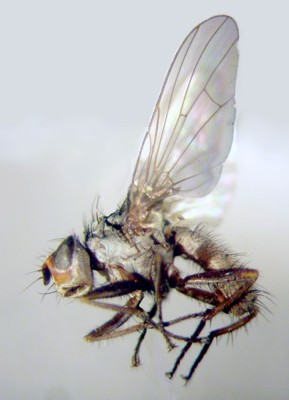Pests
Pegomyia betae Curtis. - Root Fly, Spring Cabbage Fly, Radish Maggot
Systematic position.
Class Insecta, order Diptera, family Anthomyiidae, genus Pegomyia. P. betae is a sibling species to P. hyosciami Panzer and P. mixta Villeneuve. K.Yu.El.berg (1970) in his key has given diagnostic characters for the first two species, but they have not been distinguished in Russian applied literature till 1976.Synonym.
Pegomyia hyoscyami auct.Biological group.
Pest of Chenopodiaceae cultural plants.Morphology and biology.
The species biology is similar to P. hyosciami biology. They differ in morphology of male and female genitalia. P. betae male genitalia are strongly sclerotized, darker colored, with 2 long, well developed cerci. Cercus angular, with well distinct hook in apical part; inner lobe long and straight. Female abdominal segment VIII has three sclerotized plates; ventral one is triangular, at base limbated with dark marginal stripe. Male tarsi and tibiae are usually gray (being usually yellow in P. hyosciami). Larvae of P. betae pupate in the ground only, while the larvae of P. hyosciami of the summer generation pupate more often within leaf mines.Distribution.
The species is known from Northern America, Japan, Northern and Middle Europe. In the former USSR, it is found for sure in the Leningrad region, Estonia, Latvia, Nizhnii Novgorod and Rostov Regions, and in Ukraine. In Western Europe, P. hyosciami penetrates into more southern areas, in contrast to P. betae. The two species have not been distinguished in Russian applied literature till recently. The literature data show wide distribution of P. hyosciami in the USSR; however, these records may belong to P. betae or P. mixta as well. Joint inhabitancy of two or three species is established in some regions. E.g., two species have been met on beet in Nizhnii Novgorod Region, both Root Fly and Beet Fly damaged beet, but P. betae prevailed (Berezkina, 1968). In the USSR, Pegomya flies are widely distributed in all beet-growing zones to Murmansk Region in the North, in the Nonchernozem zone, Ukraine, Caucasus, Transcaucasia, Central Asia (up to a height 3500 m in eastern Pamir), in Siberia and the Far East. In the majority of regions, the species structure of Pegomya flies is not defined.Ecology.
It is similar to ecology of P. hyosciami.Economic significance.
As against P. hyosciami, the P. betae is considered a narrower polyphage preferring to develop on beet; it lays eggs on other plant species of Chenopodiaceae (spinach, pigweed, goose-foot), but the larvae do not develop there. Larvae mine leaves. Control measures include agronomical actions promoting fast growth of culture, destruction of weeds, deep autumn plowing. Chemical ones are insecticide treatments in the period of oviposition every 7-8 days, beet seed dressing.Reference citations:
Berezkina M.I. 1968. Two species of beet mining flies. Zashchita rastenii 8: 55 (in Russian).El.berg K.Yu. 1970. Antomyiidae. In: Bei-Bienko G.Ya., ed. Keys to insects of the European part of the USSR. V. 5(2). Leningrad: Nauka, p. 458-511 (in Russian).
El.berg K.Yu. 1981. Antomyiidae. In: Narchuk E.P. & Tryapitsyn V.A., eds. Insects and mites - pests of agricultural plants. V. 4. Hymenoptera and Diptera. Leningrad: Nauka: 188-198 (in Russian).
Rogochaya E.G. 1974. Antomyiidae. In: Vasil.ev V.P. ed. Pests of agricultural crops and forest plantations. Kiev: Urozhai, v.2: 540-548 (in Russian).
Saiko V.F. 1976. Beet mining flies. Moscow: Kolos, 88 p. (in Russian).


